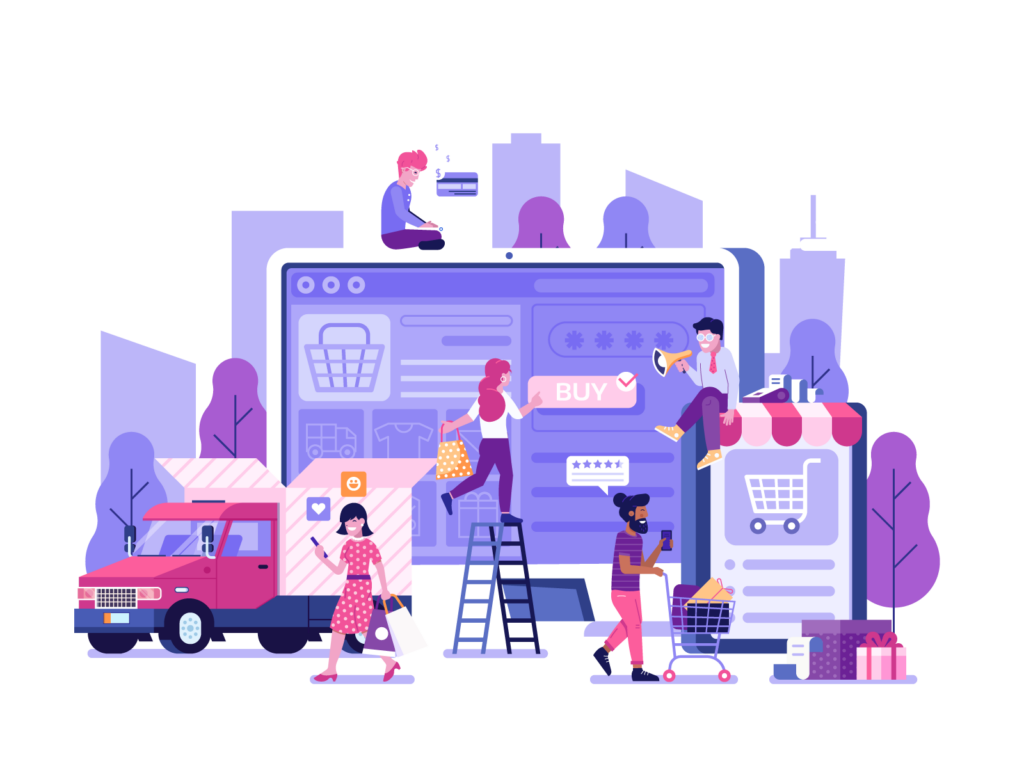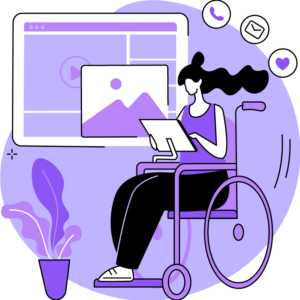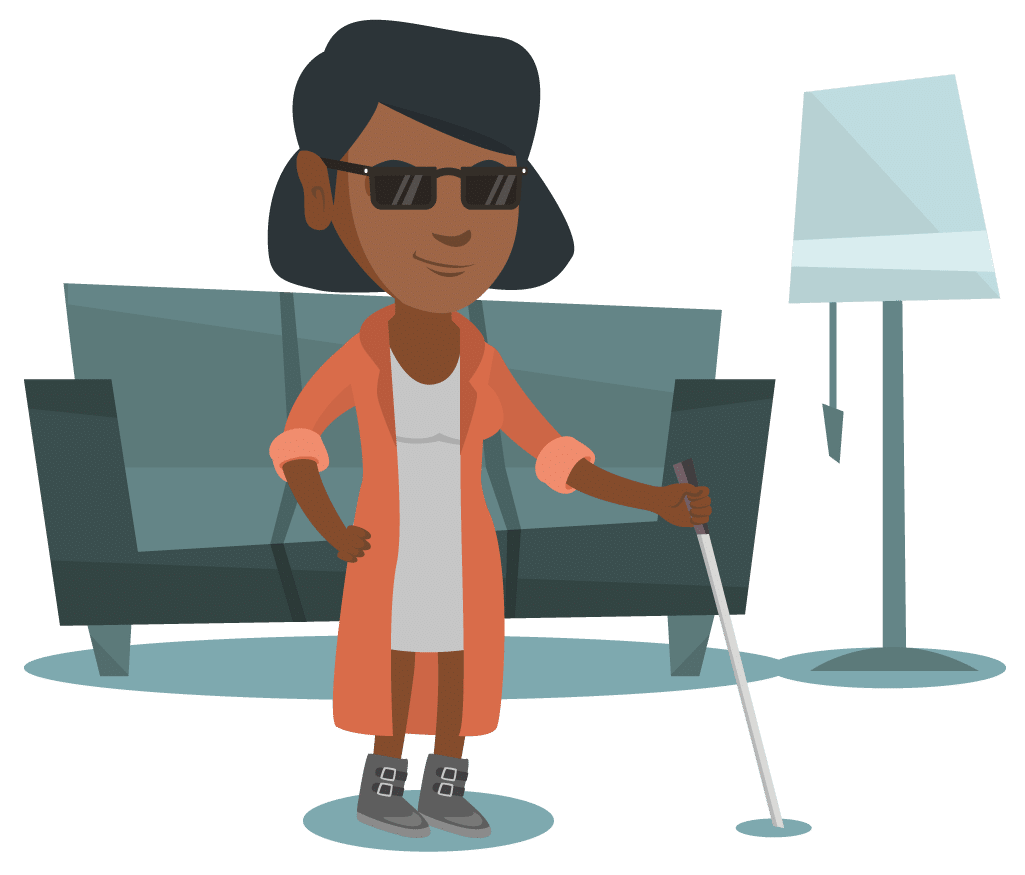How Digital Accessibility Testing Enhances Usability
A Culture of Accessibility Benefits Everyone
As millions of Americans use a variety of devices to watch programs, shop, or research the web, and work from home, a seamless user experience has become more important than ever. However, during the user experience testing of your product or platform, it’s becoming even more to understand the word “user” and the inclusivity it demands.
The term “user” is broad and includes anyone who interacts with a website, mobile application, desktop software, or streaming devices. But it’s critical to remember that not all users access digital platforms the same way, and we need to consider those people with physical or cognitive limitations the same way we consider other users. An all-inclusive approach should always be applied during usability testing to address issues that not all users experience, both for digital accessibility compliance reasons and because it is the right thing to do.
Software testing companies provide a variety of options for testing user experience, and while they think they are including all users, that is not always the case. Whether you are developing a product or maintaining an existing product, adhering to best practices for usability testing methods is vital for business and key to the experience for everyone in an equal way. Digital accessibility has become a key aspect of business and a focus of our conversations today. Additionally, the Web Content Accessibility Guidelines (WCAG) have been developed to promote compliance for those users with physical or cognitive limitations.
While digital accessibility has been given focus by many companies, there are still challenges that users with impairments are facing. We believe that by including people with physical and cognitive limitations in the conversation from the start, the result will be better products for every user.
Accessibility Should Start from the Ground Up
The conversation around accessibility has commonly been about compliance. Understanding WCAG is critical for continuing development but also for re-thinking how we approach software design from the beginning. At the core the WCAG outline four principles. These principles are just that, principles but they should put development into a broader and inclusive context that many companies and teams do not consider as deeply as they should.
1. Perceivable. Information and user interface components must be presentable to users in ways they can perceive. This means users must be able to perceive the information being presented (it can’t be invisible to all of their senses).
2. Operable. User interface components and navigation must be operable. This means users must be able to operate the interface (the interface cannot require interaction that a user cannot perform).
3. Understandable. Information and the operation of the user interface must be understandable. This means users must be able to understand the information as well as the operation of the user interface (the content or operation cannot be beyond their understanding).
4. Robust. Content must be robust enough that it can be interpreted reliably by a wide variety of user agents, including assistive technologies. This means users must be able to access the content as technologies advance (as technologies and user agents evolve, the content should remain accessible).
These principles might seem clear and comprehensive, but depending on the software and hardware specifics combined with the user perspective, the guidelines can sometimes be too broad and subjective. Some companies are testing more for compliance than overall usability as it has the appearance of being easier and cheaper. They feel comfortable believing they have met their legal requirements, but the results can sometimes fail to create an inclusive user experience, negating the entire reason for having invested in digital accessibility in the first place.
While the WCAG provides excellent guidance, when companies strictly focus on only following the standards, true usability can be overlooked. The people utilizing assistive technologies don’t know the guidelines, they just know when a product is either easy to use or extremely challenging. That’s where we come in.
At QualityLogic, we have recognized that situation and have made it a priority to test both for compliance while providing feedback on ways the client can create usability enhancements for the user. We also see it as our responsibility to push for a culture of accessibility by discussing the benefits of designing with accessibility from the ground up while including your entire potential user base, regardless of their life circumstances.
If you start from the ground up and you have imagination there is no reason you can’t come up with alternative modalities which allow people to interact. And that is really the culture of accessibility and usability which is what we need to focus on today. We need to push for people to start thinking about it before they start writing code. — Paul Morris, QualityLogic Director of Engineering and founder, Accessibility Testing Services
So, whether you are testing along with design or post-release, the goal is always to ensure inclusivity for all users. The objective is to create a seamless usability experience for everyone who will engage with the product. Expand your thinking beyond your typical audience to include individuals who are often entirely overlooked.
To do that accurately you need to understand all your users – including those with perhaps non-traditional ways of accessing your platforms, such as screen readers or other assistive technologies. Watch them use your product, talk to them about their experience, ask them what matters most and what is driving their decisions. In short, be aware of who they are, what they need, and how they are behaving. A clear understanding of those questions will help to define comprehensive testing systems that will improve user experiences for anyone.
While the answers for all users will vary, there are questions to ask that will provide the right direction for the best testing solutions. These seven questions will help understand the big picture before you start the process of usability or accessibility testing.
7 Questions to Ask for Accurate Usability Testing
1. Who is the User?
For successful usability testing, knowing who the users are is vital. That includes, what their environment looks like, and what their behavior is likely to be based on specific needs.
2. What is the problem?
Thorough testing requires a clear understanding of what the error or problem is before they can identify the right solution based on what the user is trying to accomplish.
3. What are the goals?
What does the user want to achieve from the software? What is the task they are trying to perform?
4. What features are needed?
What are the features needed for the software to function according to the user requirements?
5. What is the plan to solve the problem?
What is the approach that will identify and fix the issue, error, or problem?
6. What is the functional solution?
Is the problem related to functional performance, and if so, what is that solution?
7. How are you monitoring the solution?
What is the follow-up testing solution that will track and manage ongoing engagement?
Because the goal of usability testing is to inform and maximize design for the end-user, understanding the user needs based on who they are and where they are will be critical in developing the best product possible. Usability testing is a way to help build a better product or enhance and sustain an existing one. Accessibility testing is a logical next step and should be included in the development plan.
However, while understanding the issue and looking for the right solution might seem like the first step, it is also important to know as Paul Morris has suggested above, that if you design to accessibility and usability for everyone – including those with physical or cognitive limitations – from the beginning, you may be avoiding the problems altogether. Start by understanding the bigger picture as early as possible to avoid the potential pitfalls.
That said, it may not always be possible to start from the beginning, and there will be different considerations for usability testing depending on which phase of product development you are at— before, during, or after product release. Before the product is released, software designers might rely more heavily on prioritizing content and features in the user interface. They might also employ usability testing techniques to get feedback on the initial idea or prototype. Those techniques are different from the ones used in monitoring software functions after release. For example, let’s review post-release testing.
Ongoing Usability Testing After Release
QualityLogic provides methods that focus on usability testing to ensure functionality and user experience meet the specific requirements during the lifecycle of the product. Those considerations are as follows:
- Congruence. Does the control do what a reasonable user would expect? Does it do what users of assistive technology would expect?
- Appearance. Is the appearance consistent with the control’s function? Are the visual contrast requirements accurately incorporated?
- Accuracy. Do control labels reflect the function they perform for every user? Can they be programmatically determined by assistive technology?
- Flow. Are controls laid out in an order that flows logically over the screen? Are headlines used to organize content for a smoother assistive technology experience?
- Consistency. Is a feature’s control always represented with the same appearance throughout the system for every user?
QualityLogic also prioritizes seamless integration with the internal team to test the product early in the software development life cycle. Again, we like to start from the ground up when possible. It’s an approach that helps to ensure a more efficient product release and the best user experience for everyone. Early functional testing can prevent and detect defects immediately which means reduced testing costs, rework expenses, and improved software quality.
Choosing the right accessibility and usability testing partner is one of the most important decisions a company can make and it’s not just about the bottom line. It’s about offering the best in overall testing along with accessibility testing knowledge gained through real-life experiences.
The Best Testing Team is Blended
When considering a testing partner for accessibility, many companies are looking primarily at compliance needs, the fee, or the timeline. They might not be concerned with the approach or the people executing as long as the testing is compliant, on budget, and on time. However, QualityLogic’s Paul Morris suggests that engaging the client from the beginning and introducing a blended testing team comprised of both people with and without physical and cognitive limitations is a critical component in providing the best accessibility testing outcome.
Understanding the user first-hand allows us to meet the WCAG guidelines, but we can also submit enhancements that only a blended team can help to identify. — Paul Morris, QualityLogic Director of Engineering and founder, Accessibility Testing Services
Morris who is blind himself has also recognized that engaging clients on a level where they see the human element makes the process more compelling and starts to shift core assumptions. He says, “We have had a good degree of success in creating a passion when we create client interactions with the team made up of a blend of folks with physical and cognitive limitations and folks without. They see that the mix is most effective at creating a truly accessible product. Humanizing the process is really where it becomes successful”. He goes on to say that bringing people with physical or cognitive limitations into the conversation is the differentiating value that QualityLogic provides and something others would do well to consider.
BONUS: Accessibility Compliance: Why Automation is NOT the Only Answer
Expanding Accessibility Guidelines Beyond Compliance
To be truly inclusive is not only meeting the WCAG conformance evaluation methodology but going beyond them to deliver enhancements that make an experience better. QualityLogic believes that meeting compliance is only one aspect of creating a culture of accessibility and has expanded the guidelines to include usability practices that also address accessibility requirements.
- Testing by People Who Utilize Assistive Technology as Part of Their Daily Lives. QualityLogic’s accessibility testing is performed by team members with a variety of life situations that require assistive technology. We pair them with a QA team member who does not require the use of assistive technology for the most thorough testing results. The process enables accurate and detailed documentation of how the user interface (UI) is behaving as anomalies are encountered. This approach provides real user testing and can capture how accessibility defects behave within the user interface.
- Manual and Automated Testing. We start with automation tools that discover defects identified programmatically, such as contrast errors, structural issues, and HTML bugs. Because much of the WCAG are subjective based on human judgment, the majority of our testing is conducted manually by a team of WCAG test technicians. These technicians test using assistive technology as required by users. This provides the most realistic experience possible and captures issues that are most likely to impact the digital audience.
- Testing Across Assistive Technologies and Platforms. Some accessibility issues are third-party bugs caused by the platform or assistive technology in use. By testing across a wide variety of platforms and assistive technologies, QualityLogic will provide a comprehensive understanding of the true accessibility of the product. We monitor current market trends and reports to ensure we are using the most widely used assistive technologies.
- Compliance and Usability. Because WCAG is a set of accessibility guidelines only, there are still products developed that may meet compliance but are difficult and confusing for assistive technology users. QualityLogic provides testing results that highlight issues of non-compliance as well as issues that, though technically compliant, still lead to an inaccessible and challenging experience. This allows clients to review and prioritize issues most critical to their business.
How QualityLogic Can Help You Achieve Digital Accessibility and Create a Better User Experience
QualityLogic’s approach is tailored to the client’s needs with a focus on accessible design, bug remediation, accessibility tooling, and ongoing accessibility through organizational best practices. And while we are meeting digital accessibility goals, we will also help you to achieve better usability for everyone in the process. Our approach relies on the following principles:
- Guiding Developers to the Solution. We believe that supporting and guiding the internal development team through the process is as important as fixing the accessibility issue. Supporting developers internally will result in reduced accessibility issues in the future, higher product quality, faster time to market, and lower cost to maintain accessibility.
- A Holistic Approach. Building and maintaining an accessible product and experience requires a holistic solution. Our approach considers the organization overall and includes educating the internal team on accessibility best practices, equipping the team with the right tools for assessment, and building accessibility testing into the regular software development life cycle and testing cadence.
- Not a One-Time Fix. Just as product quality requires ongoing effort, so too does accessibility. We believe in implementing the right strategies, tools, and processes on an ongoing basis to ensure compliance and accessibility throughout the evolution and lifetime of the product.
- Accessibility Doesn’t Have to Be Hard. As experts who have operated in this space for 10+ years, and as a team that has been providing quality assurance testing for over 35 years, we are here to help navigate the landscape with efficiencies and confidence. It is our job to understand the rules, standards, and technology while identifying the nuances of compliance. We take pride in our ability to simplify your responsibilities by integrating with your business to achieve accessibility objectives which, in turn, makes your product easier for everyone.
Combined with the best testing methodologies with tools and systems, this approach and the inclusion of a blended team make testing a part of our broader mission to create a culture of accessibility. We will continue to do the work while spreading awareness for inclusivity in software development and testing and to do that we will start important conversations and pivot toward the idea that accessibility works better for every user.
Continue the Conversation Around Accessibility
With much to consider when testing for usability, we come back to that one key factor— understanding the user. It is our commitment to understand all users and to advocate for engineering practices that are inclusive for everyone from the ground up. There are four trends that we would like to put forth. If we continue to talk about impaired users as users that are just living a different life than most of us, that inclusivity will be possible without differentiation. We are hoping to shift the focus as follows:
- Approach accessibility from the ground up: Designing to accessibility from the start means a better product for all of us.
- Include people with physical and cognitive limitations in the conversation and the work: We can only test when real-life perspectives are included in the process.
- Use the right language: Stop saying disabled. Everyone has different abilities, they just use technology in different ways.
- Show the human side of technology: Understand the lifestyle of users and that they are navigating technology in different ways. Also, show the human side of assistive technology to better comprehend how to develop software for it.
When it comes down to it, usability includes accessibility and is a vital part of any software company. The aim to go beyond compliance toward inclusion is the right thing to do for the user and business. If your accessibility testing is thorough, the user engagement will be sustainable and seamless for all users not just those with physical or cognitive limitations. It also means that your brand perception will be strengthened, your culture will thrive, and your business will grow.



